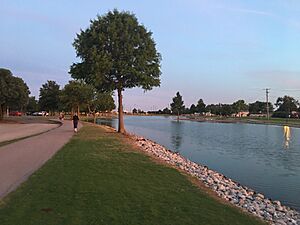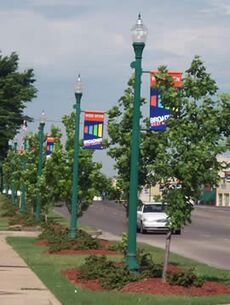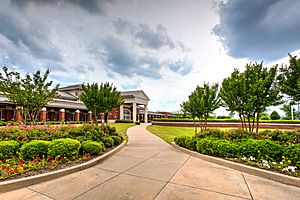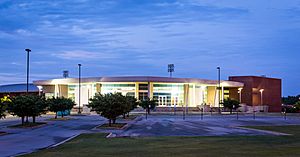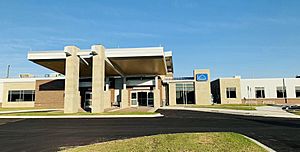West Memphis, Arkansas facts for kids
Quick facts for kids
West Memphis, Arkansas
|
||
|---|---|---|
| City of West Memphis | ||
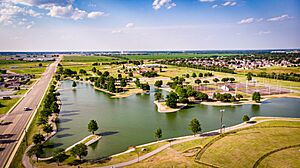
Areal view of Tilden Rodgers Sports Complex
|
||
|
||

Location in Crittenden county and Arkansas
|
||
| Country | ||
| State | ||
| County | Crittenden | |
| Townships |
|
|
| Founded | September 9, 1916 | |
| Incorporated | May 7, 1927 | |
| Named for | Memphis, Tennessee | |
| Government | ||
| • Type | Mayor–Council | |
| Area | ||
| • Total | 28.94 sq mi (74.96 km2) | |
| • Land | 28.84 sq mi (74.70 km2) | |
| • Water | 0.10 sq mi (0.26 km2) | |
| Elevation | 213 ft (65 m) | |
| Population
(2020)
|
||
| • Total | 24,520 | |
| • Density | 850.15/sq mi (328.24/km2) | |
| • Demonym | West Memphian | |
| Time zone | UTC−6 (Central (CST)) | |
| • Summer (DST) | UTC−5 (CDT) | |
| ZIP codes |
72301, 72327, 72364, 72376
|
|
| Area code(s) | 870 | |
| FIPS code | 05-74540 | |
| GNIS feature ID | 2405710 | |
West Memphis is the largest city in Crittenden County, Arkansas, United States. In 2020, about 24,520 people lived there, making it the 20th largest city in Arkansas. It's part of the Memphis metropolitan area and sits right across the Mississippi River from Memphis, Tennessee.
Contents
- Discover West Memphis: A City's Journey
- West Memphis Geography and Nature
- Population and People of West Memphis
- West Memphis Economy: A Hub of Activity
- Fun and Recreation in West Memphis
- Education in West Memphis
- City Infrastructure and Services
- Famous People from West Memphis
- See also
Discover West Memphis: A City's Journey
A Look Back in Time: Early Inhabitants
For over 10,000 years, Native Americans lived in the Mississippi River Valley. Many signs of their presence are now hidden or gone. The last native people in the West Memphis area were from the Mississippian Period. You can still see some mounds today. A marker on Mound City Road in West Memphis shows where villages like Aquixo or Pacaha might have been.
European Explorers Arrive
Explorers from Spain and France visited the West Memphis area. This included Hernando de Soto from Spain and Father Jacques Marquette and Louis Jolliet from France. By the time the French arrived, the Mississippian towns were empty. The first land in West Memphis came from Spanish grants in the 1790s.
First European Settlement: Hopefield
The first known immigrant to the area was Benjamin Fooy from Holland. In 1795, Spain sent him to start a settlement on the Mississippi River. He chose a spot across from where Memphis is today. In 1797, the Spanish built a small fort called Campo de la Esperanza. They left the fort in 1802. The area then became known as "Field of Hope" and later, Hopefield. This happened after the United States took over the Louisiana Territory.
Crittenden County's Beginnings
Crittenden County was formed in 1825, eleven years before Arkansas became a state. It's bordered by the Mississippi River to the east. The county was named after Robert Crittenden, Arkansas Territory's first secretary. In 1830, about 1,272 people lived there. Hopefield became the end point for the Memphis and Little Rock Railroad in 1857. But the Civil War stopped track building in 1861.
Hopefield During the Civil War
In the summer of 1862, Memphis was taken by Union forces. Most Confederate soldiers crossed the river to Hopefield, Arkansas. Many moved to other battles, but some stayed to bother Union forces. This became a big problem. On February 19, 1863, Union soldiers burned down the entire town of Hopefield.
Hopefield was rebuilt after the war but never became as important as it once was. In the 1890s, the St. Francis Levee District started building levees. What was left of Hopefield then became part of the Mississippi River flood plain and was washed away.
The First West Memphis Settlement
An early settlement for ferry operations between Memphis and Arkansas in the 1880s was called West Memphis. This small place was south of the current Memphis & Arkansas Bridge. It never became a city and disappeared when ferry traffic stopped. This happened after the Frisco Bridge opened across the Mississippi River in 1892. Like Hopefield, this area also became part of the Mississippi River flood plain in the 1890s.
The area often flooded in the spring. This changed after the St. Francis Levee District was created in 1893. However, private landowners had only built small levees. In 1912 and 1913, the main St. Francis levee broke. This flooded the area from the Mississippi River to Forrest City. The 1913 flood was the last time the levee broke in Crittenden County.
Founding of Modern West Memphis
After the levees were built and made stronger, Zack T. Bragg bought 300 acres of forest in 1914. He was a lumberman and started a sawmill. The mill was on a railroad track and a dirt path, which is now Missouri Street. Bragg also got rights to cut trees on thousands of nearby acres. This cleared land became rich farmland and the future West Memphis. For a few years, the area around Bragg's Mill was called Bragg, Arkansas. It was a small community with the mill, a store, a boarding house, and homes for workers.
In 1914, William H. Hundhausen started another business two miles south. It was the Bolz Slack Barrell Cooperage plant. This plant bought a lot of land for its lumber work. Soon, a small community grew around it. In 1917, Highways 70 and 61 were built through the future West Memphis. With less flood risk and new businesses and highways, the small lumber towns grew fast. In 1920, the population was about 132. By 1928, it was 350.
The community became a city in 1927 and was named West Memphis. Zack T. Bragg was elected the first mayor. William H. Hundhausen, another founder, became the third mayor. He served from 1932 to 1944.
West Memphis in the 20th Century
Railroads, lumber businesses, and new highways helped West Memphis grow. In 1930, the population was 895. By 1940, it was 2,225. By 1950, it had grown to 9,112. This made West Memphis the fastest-growing city in Arkansas. Because it grew so quickly from forests and swamps, West Memphis was called the "Wonder City" in the mid-1930s.
Growth and Music Scene
In 1917, cars started crossing the Mississippi River on special roads built on the Harahan Bridge. This bridge was for trains and opened in 1916. This helped West Memphis grow. Its main street, U.S. Highway 70 (Broadway Avenue), brought many cars through. U.S. Highway 61 (Missouri Street) was built at the same time. Where these two highways met became the center of downtown West Memphis.
West Memphis officially became a city in 1927. It grew to be the biggest city in Crittenden County. River and rail transport made West Memphis a center for making and sending goods. In the 1930s, the city faced economic hardship like the rest of the Mississippi Delta. However, it still grew quickly. West Memphis was also known for its original blues music. Famous blues artists like Sonny Boy Williamson, Howlin' Wolf, Robert Lockwood, Jr., and B.B. King once lived there.
Broadway Avenue, the city's main shopping area, grew because of more traffic and demand for goods. Tourist courts, restaurants, and hotels were built along this road. During World War II, moving soldiers and goods by road, river, and rail in the Memphis/West Memphis area created a need for places to stay. In 1949, a second car bridge opened, connecting Memphis and West Memphis. This brought even more car traffic.
The buildings on East Broadway show how much West Memphis grew from 1930 to 1958. Before the interstate highway system opened in the late 1950s, Broadway Avenue was the city's main business area. It had stores, hotels, and offices. When the interstates opened, traffic moved away from the town center. This caused Broadway Avenue to decline. While some blocks still look like they did in the 1930s-1950s, much of Broadway Avenue has changed.
Entertainment and Trucking Hub
In the 1930s, 1940s, and 1950s, 8th Street was sometimes called "Beale Street West." It had a lively music and nightlife scene, like Memphis. Places in West Memphis were linked to entertainers such as B.B. King and Elvis Presley. Other popular spots included Willowdale Inn, the Cotton Club, and the Plantation Inn.
Legal greyhound racing started in the county in 1935. The track closed several times due to floods, World War II, and fire. However, the business now known as Southland Park Gaming & Racing has been in the same spot since 1956. It is now open every day, including 24 hours on weekends.
West Memphis became a trucking center when parts of Interstate 55 opened in the 1950s. With both I-55 and I-40 going towards the Mississippi River, West Memphis became known as the "crossroads of America" for the trucking industry. In 1973, a six-lane highway bridge, the Hernando de Soto Bridge, opened north of the Harahan Bridge as part of I-40.
In 1980, Leo Chitman became the city's first African American mayor. The current mayor, Marco McClendon, is also African American. He became the youngest West Memphis Mayor in 2019.
On December 14, 1987, a tornado hit the city. It killed six people and caused about $35 million in damage. The town then flooded from 12 inches of rain on December 25, 1987. Also, 7 to 10 inches of snow fell on January 6, 1988. The melting snow made the flooding worse and added to the tornado's destruction.
Some major employers in the city are Schneider National Carriers, Southland Park Gaming & Racing, Family Dollar Distribution, FedEx National LTL, and Robert Bosch Power Tools.
West Memphis Geography and Nature
West Memphis is in eastern Crittenden County. The city of Marion borders it to the north. A small part of West Memphis reaches the Mississippi River to the south. Downtown Memphis, Tennessee, is about 8 miles east of downtown West Memphis. The city covers about 28.94 square miles (74.96 km2). Most of this is land, with a small amount of water.
West Memphis is located where two natural areas meet. The western part is the Northern Backswamps. This area used to have low-lying floodplains with trees like bald cypress and water tupelo. The eastern part is the Northern Holocene Meander Belts. These are flat floodplains and old paths of the Mississippi River. Many of the wetlands have been drained for farms or city use. The Wapanocca National Wildlife Refuge north of West Memphis protects some of the original bald cypress forests.
Population and People of West Memphis
| Historical population | |||
|---|---|---|---|
| Census | Pop. | %± | |
| 1930 | 895 | — | |
| 1940 | 3,369 | 276.4% | |
| 1950 | 9,112 | 170.5% | |
| 1960 | 19,374 | 112.6% | |
| 1970 | 26,070 | 34.6% | |
| 1980 | 28,138 | 7.9% | |
| 1990 | 28,259 | 0.4% | |
| 2000 | 27,666 | −2.1% | |
| 2010 | 26,245 | −5.1% | |
| 2020 | 24,520 | −6.6% | |
| U.S. Decennial Census | |||
Who Lives in West Memphis?
| Race / Ethnicity (NH = Non-Hispanic) | Pop 2000 | Pop 2010 | Pop 2020 | % 2000 | % 2010 | % 2020 |
|---|---|---|---|---|---|---|
| White alone (NH) | 11,563 | 8,843 | 7,024 | 41.79% | 33.69% | 28.65% |
| Black or African American alone (NH) | 15,429 | 16,608 | 16,087 | 55.77% | 63.28% | 65.61% |
| Native American or Alaska Native alone (NH) | 57 | 39 | 54 | 0.21% | 0.15% | 0.22% |
| Asian alone (NH) | 147 | 103 | 101 | 0.53% | 0.39% | 0.41% |
| Pacific Islander alone (NH) | 5 | 4 | 7 | 0.02% | 0.02% | 0.03% |
| Other Race alone (NH) | 19 | 12 | 40 | 0.07% | 0.05% | 0.16% |
| Mixed race or Multiracial (NH) | 167 | 217 | 635 | 0.60% | 0.83% | 2.59% |
| Hispanic or Latino (any race) | 279 | 419 | 572 | 1.01% | 1.60% | 2.33% |
| Total | 27,666 | 26,245 | 24,520 | 100.00% | 100.00% | 100.00% |
In 2020, there were 24,520 people living in West Memphis. There were 9,939 households and 5,964 families.
In 2010, the city had 26,245 people. About 63.3% were Black, 33.7% White, and 1.6% were Hispanic or Latino.
West Memphis Economy: A Hub of Activity
West Memphis is a center for distribution and assembly. This is because of its location and good transportation. Healthcare is also a big part of the city's economy. This includes Baptist Memorial Hospital – Crittenden and many clinics.
The city is where two major interstate highways, Interstate 40 and Interstate 55, meet. It's also near the Mississippi River, a big waterway for cargo. Large train lines like BNSF and Union Pacific also run through.
Distribution Centers and Businesses
Major companies with distribution centers here include Family Dollar, Carvana, and Bosch Tools. Manufacturers like Stateside Steel & Wire also have operations.
Ciba Specialty Chemicals has invested nearly $40 million in West Memphis since 1998. In 2003, they started building a new $1.3 million laboratory. It was finished in June 2004.
Fun and Recreation in West Memphis
City Parks and Green Spaces
West Memphis has many public parks. These include Franklin Park, Grimsley Park, Hicks Park, Hightower Park, Horton Park, Martin Luther King Jr. Park, Matthews Park, Rowe Park, Tenth Street Park, Tilden Rodgers Sports Complex, and Worthington Park.
West Memphis Gateway
The West Memphis Gateway is the main entrance to the city. The LED lights on the overpass support beams change color at night depending on the season.
Broadway Boulevard: Downtown Fun
Broadway Boulevard is the downtown area of West Memphis. It has over 84 stores and restaurants. Broadway also hosts "Blues on Broadway" events with blues singers.
Gaming and Entertainment
West Memphis is one of only two cities in Arkansas with a place for parimutuel gambling. This started many years before casinos opened in nearby Tunica, Mississippi.
In the 1990s, Southland Greyhound Park, a big employer in West Memphis, saw fewer visitors and less money. This was mainly because of new casinos in Tunica, Mississippi. By 2002, Southland was struggling.
After a $40 million investment by the park's owner, Southland added electronic games and video poker machines in 2006. This helped them hire over 300 new employees. Southland is now the third largest employer in West Memphis, with 660 employees.
Education in West Memphis
College Opportunities
- Arkansas State University Mid-South
Public Schools for All Ages
Most of West Memphis is served by the West Memphis School District. A small part of the city is in the Marion Public School District.
West Memphis district schools:
- Academies of West Memphis High School (grades 10–12)
- East Junior High School (grades 7–9)
- West Junior High School (grades 7–9)
- Wonder Junior High School (grades 7–9)
- Bragg Elementary School (kindergarten-6th grade)
- Richland Elementary School (kindergarten-6th grade)
- Faulk Elementary School (kindergarten-6th grade)
- Jackson Elementary School (prekindergarten-6th grade)
- Maddux Elementary School (kindergarten-6th grade)
- Weaver Elementary School (kindergarten-6th grade)
- Wonder Elementary School (kindergarten-6th grade)
- [closed] Wedlock Elementary School (kindergarten-6th grade)
Marion district schools:
- Marion High School (grades 10–12)
- Marion Junior High School (grades 7–9)
- Marion Math Science and Technology (K-6)
- Marion Visual and Performing Arts (K-6)
- Herbert Carter Global Community Magnet (K-6)
Private Schools
- West Memphis Christian School (prekindergarten-12th grade)
- St. Michael's Catholic School
City Infrastructure and Services
Major Roads and Highways
- Interstate 40
- Interstate 55
- U.S. Highway 61
- U.S. Highway 63
- U.S. Highway 64
- U.S. Highway 70 (Broadway Boulevard)
- U.S. Highway 79
- Highway 77
- Highway 118
- Highway 191
Healthcare for the Community
From 1951 to 2014, Crittenden Regional Hospital served the community. In December 2018, Baptist Memorial Health System opened Baptist Memorial Hospital–Crittenden. It is an 11-bed hospital focused on acute care.
Famous People from West Memphis
- Betty Blue, model and actress
- Corey Brewer, professional basketball player in Europe
- Marcus Brown, former NBA and European basketball player
- Shirley Brown, Grammy-nominated recording artist
- Michael Cage, former NBA rebounding champion
- Jekalyn Carr, gospel musician
- Sid Eudy (Sid Vicious or Sid Justice), former four-time World Heavyweight Wrestling Champion
- Ike Harris, former NFL player
- Taylor Hunt, former professional Australian footballer
- Howlin' Wolf, blues guitarist and radio performer
- Wayne Jackson, trumpet player for The Memphis Horns
- B.B. King, blues guitarist and radio performer
- Keith Lee, former NBA player
- Junior Parker, blues musician
- Sonny Weems, basketball player for Maccabi Tel Aviv
- Junior Wells, blues harmonica player and vocalist
- Sonny Boy Williamson II, blues musician
- Warren Smith, rockabilly musician
- Yebba, singer and songwriter
- YTB Fatt, rapper
See also
 In Spanish: West Memphis para niños
In Spanish: West Memphis para niños






